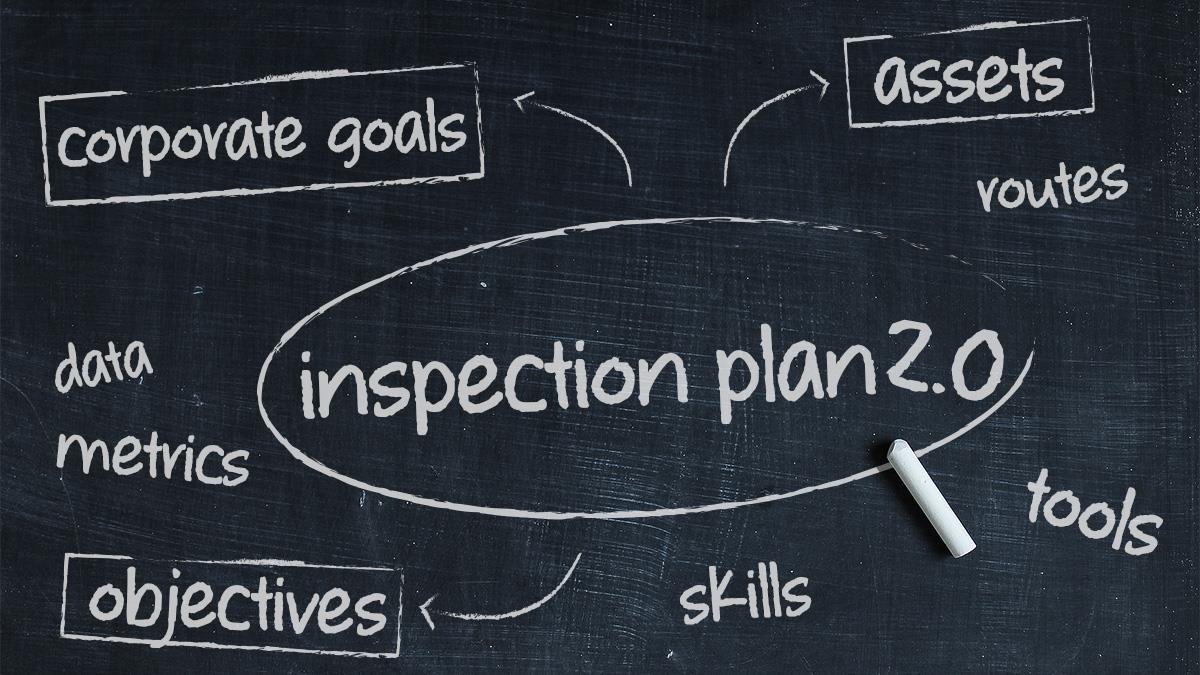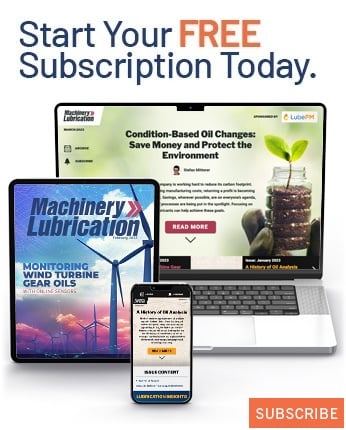
Like most business plans and strategies, an inspection plan should be built top-down. It should begin with a clear statement of corporate goals and objectives related to asset management. This approach is addressed in ISO 55001 on asset management. ICML 55, the global standard by the International Council for Machinery Lubrication, addresses optimized management of lubricated assets and is aligned with ISO 55001 guidelines. It covers inspection plans. The following refers to developing plans for Inspection 2.0, bringing inspection to a level as high or higher than condition monitoring technologies often used concurrently. Follow this link for more information on Inspection 2.0.
A full-on Inspection 2.0 plan should be a detailed and comprehensive document to ensure that key features and functional elements are not overlooked. From there, it can be abridged or streamlined for quick, readable review by technicians and operators. The unabridged version of the plan can also serve as a rough curriculum for training and competency testing for current and aspiring new inspectors.
Modern reliability and asset management programs expect documented, procedure-based work plans. This reduces the risk of variability, uncertainty and drift over time. The plan is best if it is consensus-based and should be continually improved. Before considering the input of stakeholders in writing the inspection plan, it is best to get everyone on the same page through training or self-study on the fundamental elements of Inspection 2.0 and condition-based maintenance. Of course, RCM, TPM, and asset management training would also be helpful.
Consensus-based inspection plans tap into the knowledge base and experience of skilled practitioners, old-timers and others with valuable craft skills. This provides a helpful foundation for the machine's operating conditions, critical inspection points, reliability history and known failure modes. It also establishes buy-in or ownership among operators, mechanics, technicians and other stakeholders who will be asked to execute and respond to the plan.
Further, a well-constructed inspection plan communicates the seriousness of effort and purpose. It documents that Inspection 2.0 differentiates considerably from the conventional inspection practices of the past. These differences are necessary to achieve the optimized level of machine reliability established by the asset owner. All forward progress depends on change.
When writing your inspection plan, consider the topics outlined below:
Multiple Disciplines
For many (but not all) organizations, inspections should be cross-disciplinary. They should include lubrication, mechanical maintenance, electrical, safety and operational inspections. It makes little sense to conduct one survey for lubrication, followed by a similar survey for electrical systems on the same machine. If your plant has different maintenance planners for different maintenance functions (mechanical, electrical, production, etc.), inspections can easily be divided once the information has been gathered. The critical path is getting good data and all the data. The rest will fall in place accordingly.
Ranked Failure Modes
What are the questions that inspections are supposed to answer? There could be many, but one is always your machine's general state of health. Specifically, is there confirmation of health or evidence of incipient or impending failure conditions. Therefore, we need to know the types of failures we should look for, ranked by likelihood and risk factor. Further, we need to know the specific inspection tasks and methods that can alert us to a failure in progress and how advanced it might be.
Next, we need to understand the root causes associated with each of these ranked failure modes and how inspection might recognize these root causes. One root cause can be associated with multiple failure modes. It's important to catch root causes early enough to prevent the onset of failure. We also care about knowing that all known high-risk failure modes have at least one or more methods (detectors) in our inspection plan that can reliably reveal their early presence.
Machine Inspection Ownership: Operator or Resident Expert
Each inspection task or method, defined by the inspection plan, must be performed with seriousness of purpose. The inspector should be responsible and accountable for quality work. In some organizations, the machine operator is the best choice for such an inspector. This person works physically close to the machines and can recognize subtle differences between normal and abnormal. This is often referred to as operator-driven inspection.
In other cases, the inspector may be an inspection technician who works full-time in many or all disciplines of condition monitoring, including inspection. Or perhaps the inspector is the resident expert who only does certain critical inspection routes. The advantage here is the more rigorous training and continuous practice. Combining deep inspection knowledge with a linguistic understanding of other condition monitoring technologies (e.g., oil analysis, vibration, thermography, etc.) can result in enormous value and effectiveness.
Inspection Points
Inspection points are physical locations on the machine that must be defined clearly in the inspection plan. These could be couplings, shaft/seal interfaces, breathers, hose connections, sight glasses, gauges, reservoirs, etc. Some inspection points are not visible. For instance, consider the inspection task of touching the upper inside wall of the gear case through the fill port with your fingers. The inspection is looking for moisture condensation and soft deposits. This inspection point is not visible but is necessary to assess certain headspace and lubricant conditions. Another example might be using a probe or dipstick to reach into the machine to collect inspection data.

Figure 01 Large planetary gearbox

Figure 02 Sight glass
Inspection Tasks and Methods
Knowing where to inspect is the start. Next, you must perform the inspection (or make the observation) as designated by the inspection plan. This can be extremely simple (e.g., determine the oil level from the sight glass) or a bit more complex (e.g., use a laser point to determine the abnormal presence of hard or soft particle contamination). The inspection plan must reference a procedure if the task or method involves many steps or requires special techniques or tools. The procedure is a documented method of performing certain inspections and includes the steps, the tools and the means of data collection.
Inspector Skills, Training and Qualification
Inspection 2.0 requires qualified inspectors with the skills to perform the inspection plan's tasks and methods. The more complex the inspection method or task, the more there is a need for a detailed inspection procedure and training by the inspector on that procedure. An inspector must qualify to perform inspections.
This means we can't assign inspection assignments to anybody regardless of education, work experience or responsibility. Engineers with advanced degrees don't have the skills to meet the inspection tasks defined by Inspection 2.0 based only on the engineering curriculum.

Figure 03 Stroboscope gearbox inspection
Tools Needed
Inspection must be enabled to achieve condition monitoring quality and effectiveness to its full potential. This is the essence of Inspection 2.0. As mentioned, this increasingly means modifying and accessorizing machines to inspect better and to reach new inspection points. Additionally, inspectors, like any professional or tradesperson, need a toolbox to function fully in their craft.
Many tools or inspection aids enable inspections that otherwise could not be performed. In other cases, they might reduce the time needed to complete an inspection and/or they could enhance the quality and effectiveness of the inspection. The inspection plan (or the referenced procedure) should list the tools needed. Don't cripple inspection performance by pretending to save money by scrimping on inspection tools and aids.
Inspection Findings and Data Collection
The type of inspection data to be collected and how it will be reported need to be included in the inspection plan. This can reduce the variability that could occur, for instance, by two inspectors doing the same inspections on the same inspection point using the same methods and inspection aids. It is best if data collection is uniform and has structure. This is the concept behind using a structured form or checklist on a handheld data collector or manual paper-based data collection. Inspection is data acquisition that is meaningful, quality and timely. This data doesn't stand alone but needs to be an integral part of the overall condition monitoring scheme.

Figure 04 Revealed bearing damage from a teardown inspection
Handheld electronic data collectors can show images and comparators to help more precisely score an inspection result or finding. Rather than a binary yes-or-no response, it may be scaled from 1-10. Each possible result on this scale is defined by a range of comparator images or a short narrative using the data collector's software interface. This reduces individual subjectivity and provides a scalable analog-like feature to capture and quantify the degree of changing conditions. It's essential to identify an active change.
Numerical data collection from inspection routes can be integrated with condition monitoring software to show patterns of changing conditions across an array of data types on the same machine and machine condition.
Route-based Inspections
Many inspection points can be compiled and arranged into a route for a given plant or job site. This is especially helpful when a specialized inspection instrument or tool is used on only a few machines and inspection points. Like many other route-based condition monitoring data collection tasks, its use can be scheduled.
For example, a portable water contamination tester (for lubricants) may only be needed on machines used intermittently and exposed to water sources. In other cases, it might not be a required tool but a particular skill that one inspector might have but others do not. Of course, this skill may be associated with a tool or instruction — a person trained in ultraviolet leak detection. Patch testing and wear debris analysis are other specialized skills.

Figure 05 LubePM
Most inspections are done daily by the same inspectors or operators assigned to a group of machines. These are sometimes called "walkabout" or "walkaround" inspections. They should in no way be viewed as trivial or unimportant to machine condition monitoring.
Additionally, an inspection can be condition-based, triggered by concerning data or observations flagged during a routine inspection, portable data collector or remote condition monitoring data. In such a case, routes are not needed, and the activity is more diagnostic or troubleshooting in nature.
The inspection plan should document the timing and frequency of inspection routes.
Metrics and Compliance
All business areas and processes require measurement and reporting. Based on this information, managers can make better, more informed decisions based on an accurate representation of the business and the state of their machines. This is both at a macro level (the forest) and a micro level (the trees). Managers also need lagging indicators (what just happened) and leading indicators (what will happen).
Data for these metrics can come from numerous different condition monitoring sources and then be filtered or streamlined to make them ready for decision-makers use. Just like other forms of condition monitoring, inspection is a valuable source of information related to machine reliability and asset management. This is especially true when the data quality is at the level of Inspection 2.0.
Metrics need to also include compliance. Inspections often trigger work orders to remediate current problems found by inspectors. Some work orders involve more probing inspections or troubleshooting tasks. Are these getting done in a timely fashion? Compliance tracking, measurement and reporting may also be needed to verify that all inspection routes are being effectively completed.





_small.jpeg)